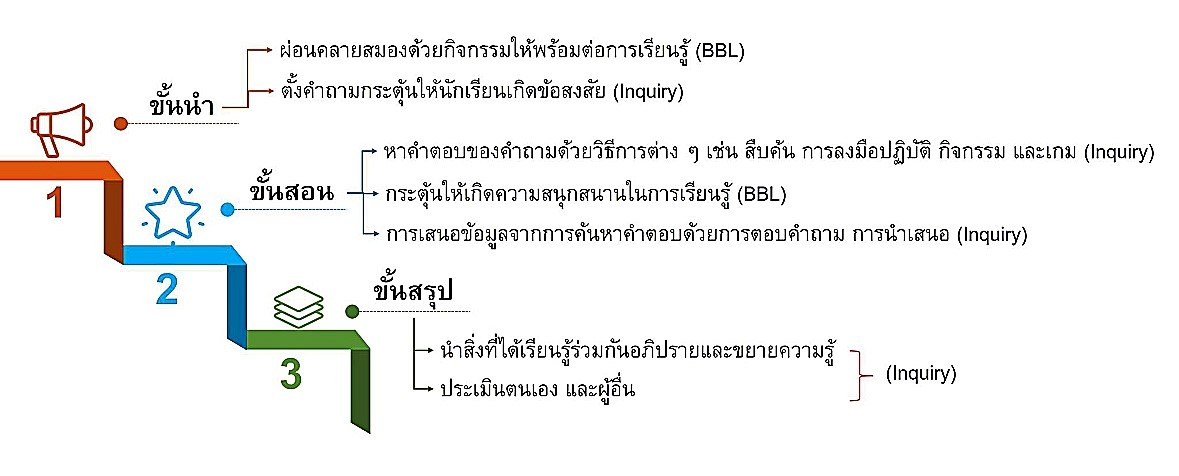การพัฒนาความสามารถทางคณิตศาสตร์สำหรับฟิสิกส์และการแก้โจทย์ปัญหาฟิสิกส์โดยจัดการเรียนรู้แบบสืบเสาะหาความรู้ร่วมกับการจัดการเรียนรู้โดยใช้สมองเป็นฐาน
Main Article Content
Abstract
Sirirat Seephuwong, Surayot Supprakob and Piyawan Masiri
รับบทความ: 13 พฤษภาคม 2563; แก้ไขบทความ: 2 กันยายน 2563; ยอมรับตีพิมพ์: 12 พฤศจิกายน 2563; ตีพิมพ์ออนไลน์: 10 พฤษภาคม 2564
บทคัดย่อ
งานวิจัยปฏิบัติการในชั้นเรียนนี้มีวัตถุประสงค์เพื่อพัฒนาความสามารถทางคณิตศาสตร์สำหรับฟิสิกส์และความสามารถในการแก้โจทย์ปัญหาฟิสิกส์ และศึกษาแนวปฏิบัติที่ดีในการจัดการเรียนรู้ เรื่อง งานและพลังงาน กลุ่มที่ศึกษาคือนักเรียนชั้นมัธยมศึกษาปีที่ 4 จำนวน 19 คน จากการเลือกแบบเฉพาะเจาะจง เครื่องมือที่ใช้ ได้แก่ แบบวัดความสามารถทางคณิตศาสตร์สำหรับฟิสิกส์ แบบวัดความสามารถในการแก้โจทย์ปัญหาฟิสิกส์ บันทึกหลังการจัดการเรียนรู้ แผนการจัดการเรียนรู้แบบสืบเสาะหาความรู้ร่วมกับการจัดการเรียนรู้โดยใช้สมองเป็นฐาน และแบบวิเคราะห์แผน การจัดการเรียนรู้ วิเคราะห์ข้อมูลด้วยร้อยละ ค่าเฉลี่ย ส่วนเบี่ยงเบนมาตรฐาน และข้อสรุปแบบอุปนัย ผลการศึกษาพบว่าความสามารถทางคณิตศาสตร์สำหรับฟิสิกส์หลังจัดการเรียนรู้มีค่าเฉลี่ยเพิ่มขึ้น 3.58 ส่วนความสามารถในการแก้โจทย์ปัญหาฟิสิกส์หลังจัดการเรียนรู้มีค่าเฉลี่ยเพิ่มขึ้น 32.11 แนวปฏิบัติที่ดี ได้แก่ 1) ใช้คำถามปลายเปิดในทุกขั้น 2) ใช้เกมการแข่งขันที่สอดคล้องกับสมองเป็นฐานในขั้นนำ 3) ใช้กิจกรรมที่หลากหลายสอดคล้องกับสมองเป็นฐานในขั้นนำและขั้นสอน 4) ใช้ปฏิบัติการทดลองในขั้นสอน และ 5) ใช้การเคลื่อนไหวร่างกายในขั้นนำและขั้นสอน
คำสำคัญ: การจัดการเรียนรู้แบบสืบเสาะหาความรู้ร่วมกับการจัดการเรียนรู้โดยใช้สมองเป็นฐาน คณิตศาสตร์สำหรับฟิสิกส์ การแก้โจทย์ปัญหาฟิสิกส์
Abstract
This classroom action research aimed to develop students’ ability of Maths for Physics, Physics problem–solving ability, and investigated the good practice of teaching in topic of “Work and Energy”. The participants were nineteen grade–10 students through purposive selection technique. The instruments consisted of Maths for Physics ability test, and Physics problem–solving test, teacher’s journal, inquiry with brain–based learning lesson plans, and lesson plan analysis forms. Data were analyzed through percentage, mean, standard deviation, and inductive process. The findings indicated that students’ ability scores of Maths for Physics increased by 3.58 points after learning, and Physics problem–solving ability scores increased by 32.11 points after learning. The good practices of teaching were included that: 1) using opened question in all steps, 2) using competitive game along with brain–based approach in warm–up step, 3) using the various activity brain–based activity in warm–up and practice step, 4) doing some experiment in practice step, and 5) using brain gym in warm–up and practice step.
Keywords: Inquiry incorporated with Brain–based learning, Maths for Physics, Physics problem–solving
Downloads
Article Details

This work is licensed under a Creative Commons Attribution-NonCommercial 4.0 International License.
References
Bybee, R. W., Taylor, J. A., Gardner, A., Scotter, P. V., Powell, J. C., Wesbrook, A., and Landes, N. (2006). The BSCS 5E Instructional Models: Origins, Effectiveness, and Applications.Retrieved from https://www. bscs.org/sites/default/files/_legacy/BSCS_5E_Instructional_Model-Executive_Sum mary_0.pdf, March 18, 2020.
Chimkul, A. (2016). Effects of Biology Learning Management Based on STEM Education Approach on Problem–solving Ability and Biology Learning Achievement of Upper Secondary School Students. Master of Education (Science Education). Bangkok: Chulalongkorn University. (in Thai)
Choosaeng, S. (2016). The Development of Tenth Grade Students’ Conception on Covalent Bond Using Model–based Learning Integrated with Dynamic Visualization. Master of Education (Science Education). Bangkok: Kasetsart University. (in Thai)
Duangmanee, D. (2017). The development of Thai–instructional skills by using brain–based learning for elementary student teachers. Journal of Chandrakasemsarn 23(45): 97–111. (in Thai)
Kemmis, S., and McTaggart, R. (1998). Action and Knowledge: Breaking the Monopoly with Participatory Action–Research. New York: Apex.
Khlaybanleng, W. (2016). Development Grade–10 Students’ Conception about Motions Using Conceptual Change Approach. Master of Education (Science Education). Bangkok: Kasetsart University. (in Thai)
Kimalee, W. (2009). Action Research for Basic Knowledge Development of Mathematics Supporting Physics Learning Unit Entitled the Wave for Mathayoln Suksa 5 students at Thumakosittwittaya School under the Office of Nakhon Phanom Educational Service Area I. Master of Education (Curriculum and Instruction). Sakon Nakhon: Sakon Nakhon Rajabhat University. (in Thai)
Phatradakun, P. (2014). A Comparison of Academic Achievement in Science and Problem–Solving Ability of Matthayom Suksa One Students Instructed by Problem–Based Learning and Brain–Based Learning. Master of Education (Teaching Science). Bangkok: Ramkhamhaeng University. (in Thai)
Phonapichat, P., Wongwanich, S., and Sujiva, S. (2014). An analysis of elementary school students’ difficulties in mathematical problem solving. Procedia–Social and Behavioral Sciences. 116: 3169–3174.
Pornkun, C. (2012). Teaching theoretical and applied thinking processes. 2nd ed. Bangkok: V-print (1991). (in Thai)
Porntrai, S. (2016). Learning Kreb’s cycle in cellular respiration through science inquiry: A hands–on activity for improving academic achievement. Journal of Research Unit on Science, Technology and Environment for Learning 7(2): 285–297. (in Thai)
Putthamonsing, S., and Bhiasiri, S. (2016). A study of basic mathematics knowledge to be used by grade 11 students in physics subject using Polya’s problem solving steps together with KWDL Technique. Journal of Education Khon Kaen University (Graduate Studies Research) 10(Special): 141–147. (in Thai)
Salin, T., Sirisawat, C., and Pibanchon, S. (2019). A study of physics achievement physics problem solving skill and education attitude for physics on momentum and collision of 11th grade students using inquiry method of teaching enhanced by using Polya’s problem solving technique. Journal of Education Naresuan University 21: 93–108. (in Thai)
Somchat, P. (2014). The Development of Tool Kits in Problem Solving on the Topic of Work and Energy through 5E–Inquiry Circle for Mathayom Suksa V Students. Master of Education (Curriculum and Instructional Development). Graduate School, Ubon Ratchathani: Ubon Ratchathani Rajabhat University. (in Thai)
Sriwongsa, K. (2013). The Development of Achievement in Physics by Using Study the Basic Mathematics of Physics for Matthayomsuksa 6/1 The Demonstration School of Silpakorn University. Master of Education. Bangkok: Silpakorn University. (in Thai)
Suwanmolee, U. (2020). Solving Mathematical Problem Solving in Physics Subject by Using Exercise Exercises. Retrieved from http://www.sing.ac.th/News/ files/366.pdf, March 18, 2020. (in Thai)
Tangpet, N. (2013). The Development of Grade 11 Students’ Concepts of Sensation and Response of Living Things by Using Brain–based Learning: An Action Research. Master of Education (Science Education). Bangkok: Kasetsart University. (in Thai)
Utto, W. (2016). The Study of Grade 10 Students’ Conceptions on Covalent Bonding through Active Learning. Master of Education (Science Education). Bangkok: Kasetsart University. (in Thai)
